Satellite Images of Emiliania huxleyi Blooms
[click on the small pictures on this page to view them at full size]
[Story of the discovery of Ehux blooms by satellite]
Shown below are some satellite pictures of blooms of Emiliania
huxleyi. The coccolith platelets carried by the cells cause reflection
of light, making the sea look brighter and hence distinctive in satellite
images. Thus satellites enable us, for this species, to delimit the precise
extent of its blooms in the sea. Satellites can also detect the presence of
chlorophyll in the water, but as a rule cannot distinguish which species are
responsible.
The ability to delineate the extent of single-species blooms is an important
tool for ecology. For instance, satellites show us that blooms develop
simultaneously over a wide area. Their onset is much faster than would be
possible if blooms were caused by a "seeding effect", with the initial cells
of the bloom being physically transported from elsewhere to start the bloom
off. Therefore we can estimate that seeding effects are not very important
in phytoplankton ecology. Remote sensing of this single species also allows
us to estimate its individual biogeochemical importance.
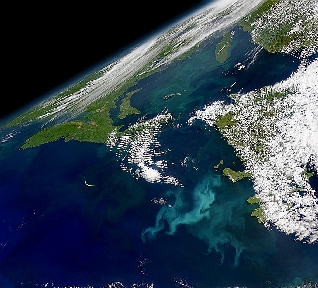
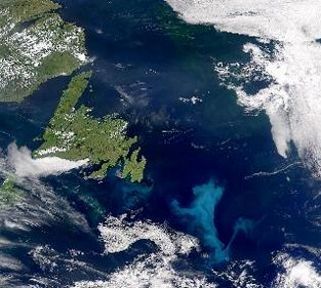
Two beautiful
SeaWiFS
satellite images of blooms off Newfoundland in the western Atlantic, the
left-hand on 21st July 1999, the right-hand one on 16th July 2000. Humanity
has invested billions of dollars putting satellites into space; these images
are part of the reward.


Blooms are not often seen close to the coast of Greenland. However, this
image shows a bloom at about 65 degrees N, to the east of the icesheet covering
Greenland. it was taken on July 27, 2003.
MODIS images are courtesy of
Jacques Descloitres, MODIS Land Rapid Response Team at NASA GSFC.

Two more stunning
SeaWiFS
satellite images of a coccolithophore bloom cradling the Falkland Islands
(Patagonian Shelf), the left-hand one on 29th November 1999, the right-hand
one two weeks later on 13th December. Water sampling has confirmed bright waters
in the area to be due to abundant coccolithophores.



Oct 10th 2000 (left) and Sep 12th 2000 (middle) in the Bering Straits /
Bering Sea, and late summer 1997 (right) in the eastern Bering Sea. Water
samples taken near St. Paul Island in early October 1997 contained abundant
Ehux coccoliths.
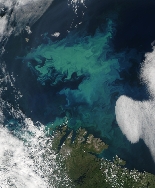

Ehux bloom in the Barents Sea (north of northern Norway) on July 27th 2004
(left) and a wide-angle picture on July 30th 2004 (right). First picture
from MODIS,
second from SeaWiFs. MODIS images courtesy of Jacques Descloitres, MODIS
Land Rapid Response Team at NASA GSFC.

Satellite picture of a bloom in the Skagerrak and along the Norwegian coast,
May 31st 2000. Ehux is well known to produce white waters in this area.


Satellite pictures blooms in the North Sea, Jun 5th 2003 (left) and June
10th 2000 (right).





SeaWiFS satellite images of (a) a bloom to the SW of Ireland, 10th
May 2000, (b) small bright patches in the western approaches to the
English Channel, 26th June 2000, (c) larger bloom in the same area, 12th
june 2003, (d) both areas together with the Bay of Biscay, 21st May
2001, and (e) bloom in the Bay of Biscay, May 16, 2004 (this image from
MODIS, courtesy
of Jacques Descloitres, MODIS Land Rapid Response Team at NASA GSFC).
Previous bright summer waters have been positively identified as Ehux in
these areas.
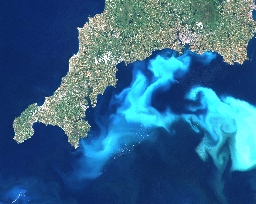
LANDSAT satellite image of a
bloom in the English Channel off the coast of Cornwall, 24 July 1999. The
bloom was sampled six days later by scientists at Plymouth Marine Laboratory
and positively identified as Ehux. Image courtesy of Andrew Wilson and Steve
Groom.


SeaWiFS images of Ehux blooms (as verified by water sample analyses
using an SEM) in the Black Sea: (left) June 13 2000 and (right) June 12
2000. Note the colour contrast between the deep blue of the eastern
Mediterranean and the paler colour of the Black Sea.

Probable Ehux bloom (bright waters have not been previously sampled here)
between Tasmania and New Zealand, 17th Jan 1999.
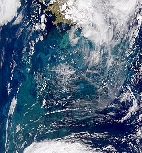
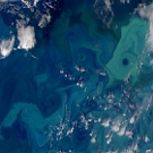
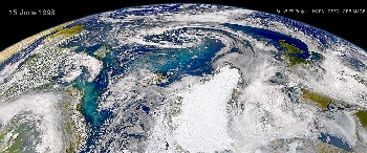
Three further satellite images
(SeaWiFS)
of a bloom south of Iceland, this time June 15th, 1998.
Additional pictures from the
Bering Sea,
Barents Sea,
Black Sea,
northern North Atlantic,
western North Atlantic,
Patagonian Shelf.
Pictures from older satellites
What do the satellite sensors actually look like? They are surprisingly
small. Many of the images above were obtained with the
SeaWiFS sensor. The
global bloom distribution
was produced using the
CZCS sensor.
Temporal development of a bloom along the Norwegian Coast
Ocean in Motion: a video clip prepared from successive
satellite images of the extensive 1991 Ehux bloom south of Iceland, with the
coccoliths act as visual tracers highlighting, literally, ocean currents
moving across the bloom area (produced by Steve Groom).
[Unless otherwise stated, all images on this page were provided by the
SeaWiFS Project, NASA/Goddard Space Flight Center and ORBIMAGE. Many thanks
to Norman Kuring (NASA/GSFC) for help with images]
Ehux
home page
Toby Tyrrell : T.Tyrrell@noc.soton.ac.uk
























